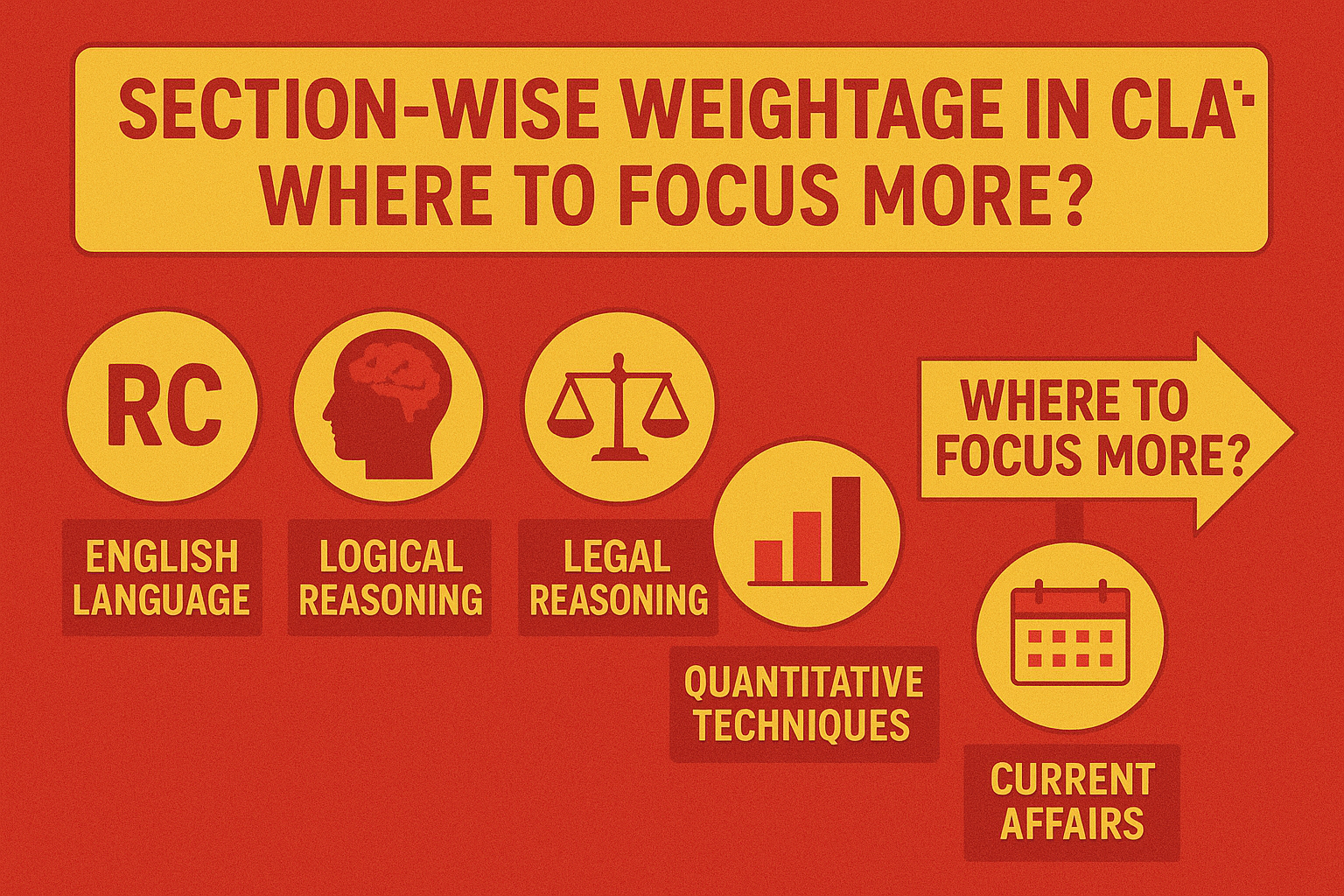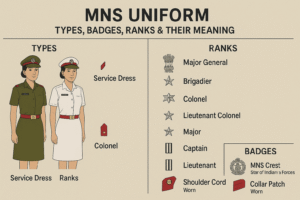A Smart Guide to Maximize Your CLAT 2025 Score
Understanding the section-wise weightage in CLAT is one of the smartest things a candidate can do to improve their preparation. CLAT is not just about hard work—it’s about targeted and efficient preparation. With a total of 150 questions distributed across five major sections, knowing where to focus more can help you score higher and save valuable time.
In this article, we will provide a detailed section-wise analysis, recent trends, and tips on how to prepare according to the weightage of each section.
CLAT 2025 Exam Pattern at a Glance
| Section | No. of Questions | Weightage (%) | Difficulty Level |
|---|---|---|---|
| English Language | 28–32 | ~20% | Moderate |
| Current Affairs & GK | 35–39 | ~25% | Moderate to High |
| Legal Reasoning | 35–39 | ~25% | Moderate |
| Logical Reasoning | 28–32 | ~20% | Moderate to High |
| Quantitative Techniques | 13–17 | ~10% | Moderate to Difficult |
| Total | 150 | 100% |
1. English Language (28–32 Questions)
What It Includes:
Reading comprehension passages
Vocabulary (meaning, synonyms, antonyms)
Grammar-based questions
Inference, tone, and summary
Focus Areas:
Improve reading speed and comprehension accuracy
Practice editorial passages from newspapers like The Hindu or Indian Express
Learn 1000+ high-frequency words and grammar rules
Why It Matters:
It’s a high-scoring section if you are consistent with practice. Passages are comprehension-based, so rote learning won’t help—daily reading is key.
2. Current Affairs & General Knowledge (35–39 Questions)
What It Includes:
Monthly current affairs
Legal and national events
International news
Awards, government schemes, appointments
Focus Areas:
Focus on the last 10–12 months of current affairs
Prioritize legal GK and contextual static GK
Use GK capsules, monthly PDFs, and editorials
Why It Matters:
One of the heaviest sections by weightage, and one where most toppers gain an edge. The challenge is not just knowing facts, but applying them in passage-based questions.
3. Legal Reasoning (35–39 Questions)
What It Includes:
Legal principles and their application
Recent laws, judgments, and legal news
Reading long legal passages and answering context-based questions
Focus Areas:
Practice daily legal reasoning questions
Learn basic legal terms and principles
Stay updated with Supreme Court judgments, legal amendments
Why It Matters:
A core section for CLAT, legal aptitude is critical to your score. Good preparation here reflects your suitability for law school. Also, it overlaps with GK in many questions.
4. Logical Reasoning (28–32 Questions)
What It Includes:
Critical reasoning
Arguments, assumptions, conclusions
Syllogisms, cause-effect, statement-assumption
Focus Areas:
Focus on passage-based reasoning
Practice previous years’ questions
Understand the structure of arguments and logical flaws
Why It Matters:
This section tests thinking clarity and deduction skills. It can be tricky, but regular practice builds accuracy.
5. Quantitative Techniques (13–17 Questions)
What It Includes:
Data interpretation (bar graphs, tables, pie charts)
Basic arithmetic (percentages, averages, ratios)
Short caselets with numerical questions
Focus Areas:
Brush up Class 8–10 level maths
Practice graph-based questions
Focus on speed calculation and estimation
Why It Matters:
Though this section carries less weight, it can give you a competitive advantage if others skip it. Just 10–12 correct answers can boost your rank significantly.
Where to Focus More: Strategy by Weightage
| Section | Priority Level | Suggested Time Daily | Key Tip |
|---|---|---|---|
| Legal Reasoning | High | 1.5 hours | Practice 3–4 passages + legal news |
| Current Affairs & GK | High | 1 hour | Revise weekly/monthly compilations |
| English Language | Medium-High | 1 hour | Read editorials, practice vocab |
| Logical Reasoning | Medium | 1 hour | Solve 2–3 critical reasoning sets |
| Quant Techniques | Medium-Low | 30–45 mins | Focus on DI and arithmetic short tricks |
Tips for Balanced Preparation
Start with Legal Reasoning and GK: They carry the most weight and are most scoring.
Use mocks and sectional tests to evaluate time spent per section.
Prioritize quality of understanding over quantity of questions solved.
Practice passage-based solving daily, especially in English and Logical Reasoning.
Revise legal and current affairs daily to avoid last-minute overload.
SEO Keywords to Include
CLAT section wise weightage
CLAT 2025 preparation strategy
important sections in CLAT exam
focus areas for CLAT
CLAT marks distribution
CLAT legal reasoning weightage
CLAT GK vs Legal GK
CLAT exam pattern 2025
FREQUENTLY ASKED QUESTIONS (FAQs)
Q1. Which section carries the highest weightage in CLAT?
The Current Affairs & GK and Legal Reasoning sections usually have the highest number of questions—about 25% each.
Q2. Is Quantitative Techniques important for CLAT?
Yes, even though it has fewer questions (10–12%), scoring here can significantly boost your overall rank, especially since many students avoid this section.
Q3. How many questions should I aim to attempt in CLAT?
Aim to attempt 120–130 questions with high accuracy. Avoid blind guessing, as there’s negative marking.
Q4. How can I manage time between all sections?
Create a daily schedule that gives more time to Legal, GK, and English, and rotate Logical Reasoning and Quantitative Techniques every alternate day.
Q5. Does the CLAT paper pattern change every year?
While the number of questions may slightly vary, the overall structure and passage-based format remain the same. Always check the official notification for updates.
Conclusion
Preparing for CLAT with a clear understanding of section-wise weightage allows you to study smart, not just hard. Legal Reasoning and GK are your top priority, but the other sections must not be ignored. Focus on reading comprehension, analysis, and reasoning — all key components of the CLAT paper.
Craft your preparation plan based on this weightage guide and make every hour count. The smarter your focus, the better your score.






